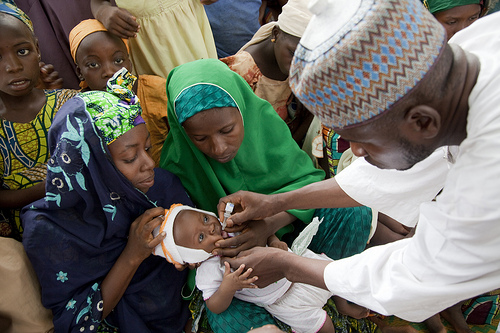Worldwide, 12.9 million infants, nearly one in 10, did not receive any vaccinations in 2016, according to a recent World Health Organisation (WHO) and United Nations Children’s Fund (UNICEF) immunisation estimates. This means, critically, that these infants missed the first dose of diphtheria-tetanus-pertussis (DTP)-containing vaccine, putting them at serious risk of these potentially fatal diseases.

Additionally, an estimated 6.6 million infants who did receive their first dose of DTP-containing vaccine did not complete the full, three dose DTP immunisation series (DTP3) in 2016. Since 2010, the percentage of children who received their full course of routine immunisations has stalled at 86% (116.5 million infants), with no significant changes in any countries or regions during the past year. This falls short of the global immunisation coverage target of 90%.
“Most of the children that remain un-immunised are the same ones missed by health systems,” says Dr Jean-Marie Okwo-Bele, Director of Immunisation, Vaccines and Biologicals at WHO. “These children most likely have also not received any of the other basic health services. If we are to raise the bar on global immunisation coverage, health services must reach the unreached. Every contact with the health system must be seen as an opportunity to immunise.”
Immunisation currently prevents between 2–3 million deaths every year, from diphtheria, tetanus, whooping cough and measles. It is one of the most successful and cost-effective public health interventions.
Global immunisation coverage levels
According to the new data, 130 of the 194 WHO Member States have achieved and sustained at least 90% coverage for DTP3 at the national level – one of the targets set out in the Global Vaccine Action Plan. However, an estimated 10 million additional infants need to be vaccinated in 64 countries, if all countries are to achieve at least 90% coverage. Of these children, 7.3 million live in fragile or humanitarian settings, including countries affected by conflict. 4 million of them also live in just three countries – Afghanistan, Nigeria and Pakistan – where access to routine immunisation services is critical to achieving and sustaining polio eradication.
In 2016, eight countries had less than 50% coverage with DTP3 in 2016, including Central African Republic, Chad, Equatorial Guinea, Nigeria, Somalia, South Sudan, Syrian Arab Republic and Ukraine.
Globally, 85% of children have been vaccinated with the first dose of measles vaccine by their first birthday through routine health services, and 64% with a second dose.
Nevertheless, coverage levels remain well short of those required to prevent outbreaks, avert preventable deaths and achieve regional measles elimination goals.
Some 152 countries now use rubella vaccines and global coverage increased from 35% in 2010 to 47% in 2016. This is a big step towards reducing the occurrence of congenital rubella syndrome, a devastating condition that results in hearing impairment, congenital heart defects and blindness, among other life-long disabilities.
Global coverage of more recently-recommended vaccines are yet to reach 50%. These vaccines include vaccines against major killers of children such as rotavirus, a disease that causes severe childhood diarrhoea, and pneumonia. Vaccination against both these diseases has the potential to substantially reduce deaths of children under five years of age, a target of the Sustainable Development Goals (SDGs).
Many middle-income countries are lagging behind in the introduction of these newer and more expensive vaccines. These countries often do not receive external support and their health budgets are often insufficient to cover the costs of procuring these vaccines.
Inequities in immunisation coverage
National coverage estimates often mask large inequities in coverage within countries. The WHO report, State of inequality: Childhood immunisation, highlights inequalities in childhood immunisation coverage in low- and middle-income countries over the past 10 years. The report shows that global improvements have been realised with variable patterns of change across countries and that there is generally less inequality now than 10 years ago.
These findings were reinforced by a recent UNICEF study, which emphasised the cost effectiveness of investing in the poorest, most marginalised communities.
“Immunisation is one of the most pro-equity interventions around,” says Dr Robin Nandy, Chief of Immunisations at UNICEF. “Bringing life-saving vaccines to the poorest communities, women and children must be considered a top priority in all contexts.”
Efforts to reduce inequalities related to household economic status and mother’s education are needed in many countries if immunisation coverage is to be improved. Additionally, more than half of the global population resides in urban areas, including in rapidly growing slums in Africa and Asia. The urban poor is a group at high risk of being un- or under-immunised.
For the first time, WHO and UNICEF have collected disaggregated data on immunisation coverage at the subnational level. Of 194 reporting countries, 125 reported on subnational coverage, covering nearly 20 000 districts and roughly two-thirds of the global infant population. These data will help shed more light on geographical disparities in access to vaccines.
Since 2000, WHO and UNICEF jointly produce national immunisation coverage estimates for each of the 194 WHO Member States on an annual basis. In addition to producing the immunisation coverage estimates for 2016, the WHO and UNICEF estimation process revises the entire historical series of immunisation data with the latest available information. The 2016 revision covers 37 years from 1980 to 2016.
